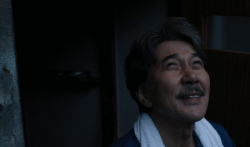The Air and Space Museum is fancy. Really fancy. The exhibits light up and elaborate spaceship parts hang from the ceiling. The escalators aren’t hidden off to the side because they fit right in with the style of the museum. There are little children running around! Did I mention that shit LIGHTS UP?
So, um, serious art on display? Don’t be surprised that Wang Ming’s “Universal Dimensions” exhibit is awkwardly situated at the end of the atrium, only differentiated from the “new wave exhibits” by the uncarpeted floor and the palpable indifference with which it is treated by the museum’s main demographic group (it isn’t easy to enjoy the pensive works displayed in a space where adults carry on cell-phone conversations and kids take a seat along the wall).
If you can get the loitering parents to clear out by awkwardly peering over their heads at the pieces, then you’ll see “Universal Dimensions” is an impressive exhibit from an intriguing artist.
Ming’s history is the prototypical American immigrant story, and his art is fittingly American. Having escaped the turmoil of China to arrive in the United States in 1951, Ming had never painted before, making a living as a framer in both countries, and his occupation would later influence his works.
A willingness to experiment with different mediums shines through in all of Ming’s works; for some of his pieces, the artist blew up engraved negatives of photographs and painted on the resulting product, as in the fantastic “Golden Space.” The blurry brushstrokes contrasting with the large spherical image that made up the original photograph showcase the most recurring themes in his work: the conflict between chaos and control.
The exhibit incorporates many quotes by the artist on balancing “the rational” and “the intuitive” (two opposing ideas he claims to have acquired from living in America and China, respectively) and the “ancient Chinese notion of yin and yang.” That Ming portrays the two as blurs and circles adds to the “outer space” feeling of most of his works, but he is concerned as much with “inner space” as outer, most obviously apparent in “Nuclear Dimension,” which evokes both outer space and molecular bodies.
The pieces that deal more subtly with the idea of “inner space,” though, are the most impressive. In the same way that Rothko showed the scope of human emotion with impressively sized canvases and smart color schemes, Ming shows how inner space can be as grand as outer. “Cosmic Body,” made around the same time that the color field painters were at their peak, conveys joy with vibrant colors but with a distinctly Chinese influence.
The “Explaining the Essence of Eternity” triptych is perhaps the finest work of them all, bringing together all of Ming’s influences into one work that is grand in scope and contrasting carefully controlled circles and expressive brushstrokes. As small children run by while you try to appreciate the work, you understand it, too: harmony vs. chaos.




